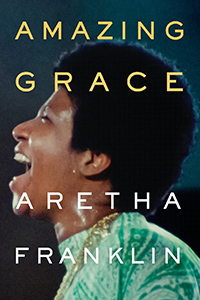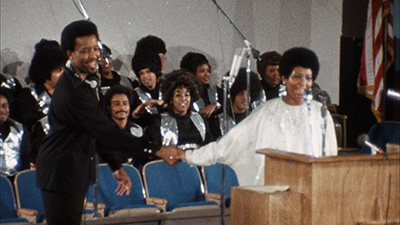Watching Amazing Grace, the Aretha Franklin concert film released earlier this year, is like opening the door to a secret laboratory. We see Franklin, then twenty-nine years old, singing in the musical testing ground she’d known since birth, a church full of people. At the piano is the Rev. James Cleveland, the gospel innovator whose heavily-chorded piano style Franklin had learned sitting beside him in her childhood living room. In front of the piano sit the two greatest influences on her singing style: her father, the celebrated Baptist minister C. L. Franklin, and his romantic companion, the gospel diva Clara Ward. The choir’s arrangements are as crisp as their sparkling vests. The New York session pros in Franklin’s band lock into every groove their boss gives them. And for two nights, the boss and her once-in-a-generation voice reveal to the wider world a teeming religious subculture, one whose elements and experiments had made Franklin’s music a defining sound of the late sixties.

When she recorded her gospel music concert in January of 1972, Franklin had reached the peak of her vocal and hitmaking powers—which is to say, she was better at being a pop star than anyone else in the world. For Atlantic Records, she’d scored top-ten hits with originals (“Think,” “Rock Steady”) and definitive versions of other people’s songs (Otis Redding’s “Respect,” Burt Bacharach and Hal David’s “I Say a Little Prayer”). Her voice was such a natural phenomenon that she had to treat her band members like unicyclists at the Grand Canyon, warning them not to pay attention to her lest they lose focus and crash. Beyond that, she was a master technician who ran rehearsals and often dictated song arrangements to her bands. These contributions went largely uncredited. Amazing Grace was the first album to list her as a producer. Accounts differ over who had the idea for an Aretha gospel album—producer Jerry Wexler and Franklin herself have both taken credit—but everyone agreed it was a good idea, and that they should record the album live before a church audience. They wound up at New Temple Missionary Baptist Church in Los Angeles, backed by James Cleveland’s Southern California Community Choir and documented by Sydney Pollack’s film crew. The resulting double album was spectacular.
Don’t just take my word for it. Marvin Gaye once called it “Aretha’s singular masterpiece.” “Aretha has been working on this album all her life,” Phyl Garland wrote in Ebony in 1972, “for it is the consummation of the fundamental musical forces that have shaped her as an artist. In short, it is nothing less than amazing.” Gospel music expert Anthony Heilbut applauded Franklin’s choice of Cleveland and his choir: “Here was a marriage made in heaven, absolute proof that the best gospel musicians remain uniquely attuned to the singers they accompany.”
“[T]hough it might sound like hyperbole,” Wexler told Franklin’s biographer David Ritz, Amazing Grace “relates to religious music in much the same way Michelangelo’s Sistine Chapel relates to religious art. In terms of scope and depth, little else compares to its greatness.”
Wexler may be biased because he co-produced this particular Sistine Chapel, but he makes a good point. The Amazing Grace program is great because it encompasses worlds. Franklin’s expansive vision of gospel recalls the radical egalitarianism of Paul’s early letters. In Franklin’s gospel there is no longer sacred or secular, traditional or modern. She embraces both her father’s Baptist tradition and the wilder two-steps of her Pentecostal brethren, those sanctified believers her drummer Bernard Purdie called the “holy-rolly church.” Her music suggests gospel music is a well without a bottom.
Compared to the subtly overdubbed and re-ordered album, the movie is rough around the edges. During filming, Pollack and his crew infamously forgot to clap the clapperboard, so image and sound remained unsynchronized until 2010. Even then, Franklin blocked the film’s release; her estate finally approved it after her death. Many of the crowd shots lack sound, leading to the weird spectacle of audience members silently shouting or clapping out complicated patterns we can’t hear. Worse, the DVD release lacks any bonus features at all. Who knows what footage is still out there? After watching the film’s sole rehearsal scene, with Franklin and the band tersely working out the intro to “How I Got Over,” it’s impossible not to want more. And why, in “Mary Don’t You Weep,” did the restoration team omit the crucial minute where Franklin calls forth Lazarus from the giddiest point of her high range, working the crowd into a resurrection frenzy?
Still, the eighty-nine minutes we see are remarkable. At the center is Franklin’s technically stunning singing, always passionate but never forced. Her husky low notes sound warm and inviting, like cushions; her high notes whoosh as though she’s unburdening herself and her listeners of weights so old that they’d simply faded into life’s background. Plenty of singers in the 1970s made singing sound easy, but Franklin’s ease inhabits a different universe than that of Karen Carpenter, Bill Withers, or James Taylor. She applies her ease to performances of spellbinding virtuosity.

In particular, the evenings’ closing songs come across better on film than they do on record, because we see the iron hold Franklin had on her audiences. Her meditative, meterless renditions of “Amazing Grace” and “Never Grow Old,” sung in the “free” style pioneered in the 1930s by Willie Mae Ford Smith, render her audience tearful and breathless. Franklin spends around ten minutes getting through two and a half verses of “Amazing Grace,” and she uses every second. The first verse announces the song with a straightforward technique: She holds a syllable (“waaaaaaaaaaaaaaas”) to its breaking point, eliciting murmurs and applause, then repeats the word with the syllable that follows (“was lost”), allowing everyone to sigh with relief. The verse becomes sixteen long bars of tension and release. By the time she reaches the second, more elaborately improvised verse, the church is quivering like an exposed nerve. The smallest unexpected nuances spark chuckles of appreciation; the syncopated jolt of “It was! It was! It was! It was! It was graaaaaaaaace” drives people to their feet.
This singing style was older than Franklin, but it was also, in its own cloistered and churchy way, ahead of its time. Writing a year before the Amazing Grace album was released, Heilbut pointed out that “Willie Mae could easily get a two-hour concert out of ten songs, many years before John Coltrane popularized the fifteen-minute solo.” Indeed, Franklin’s versions of “Amazing Grace” and “Never Grow Old” are stretched to the point of abstraction. They seem to allow Franklin unmediated communion with her listeners. When Franklin died in 2018, the critic Greg Tate compared her to jazz masters Coltrane and Ornette Coleman, writing that she “was free with her harmonic and melodic feelings in ways we typically refer to as avant-garde.”
On those rare occasions they received negative press, Franklin and Coleman even riled their detractors in similar ways. Forced to assess Franklin’s recordings of standards for Hi Fi/Stereo Review in 1967, an irate Rex Reed complained, “it always occurs to me that there must be a better way, a way that will preserve the song from destruction and leave the listener with a portion of his sanity. Her delivery overpowers all meaning, all semblance of order and dignity.” Similarly, Downbeat magazine’s John A. Tynan initially dismissed Coleman’s landmark album Free Jazz as a “maelstrom.” After asking the unanswerable question, “Where does neurosis end and psychosis begin?” he concluded that Coleman and his fellow musicians must have conspired “to destroy the music that gave them birth.” Some enterprising copywriter should have worked these critiques into an ad. “Ornette and Aretha: Dead-set on destruction, and driving listeners INSANE!”
Throughout the film, we see Franklin test the extent of her command over instrument and audience. She summons all the dangers, toils, and snares of the past, along with all the promise of her heavenly home, and ushers them into the room for all to see. Chronological time becomes irrelevant. This immediacy drives people to cry, laugh, and dance. During the last song, Clara Ward’s mother Gertrude kicks up a holy ruckus, stomping over to the piano from the other side of the sanctuary and gesticulating wildly before being restrained.
Watching such raw displays of emotion might make outsiders feel like voyeurs. The concert audience was mostly parishioners who’d grown up worshiping in the gospel church, but the second night saw some curious—and famous—guests from beyond New Temple’s walls. Amazing Grace is the rare movie to make Mick Jagger seem like a hapless everyman. At several points the camera catches him in the audience, grooving eagerly and trying to get Rolling Stones drummer Charlie Watts to clap along. The Stones knew gospel and presumably loved it—Jagger had occasionally attended church with gospel keyboardist Billy Preston—but they were keenly aware that it wasn’t their music. In choruses like their asocial call-and-response, “Hey! (Hey!) You! (You!) Get off of my cloud,” they’d twisted the techniques of African-American musicians beyond their original concerns. (Singing along to “Get Off of My Cloud,” the critic Frank Kogan writes, “the audience is participating in its own rejection, if it wants…being empowered and unified in self-division and self-destruction.”) For better or worse, most pop and rock fans still know gospel music not as an innovative, self-sufficient art, nor as a devotional medium, but as source material for the music they really love.
Amazing Grace answers that concern with a beautiful “Yes, and…” Yes, gospel singers did inspire the early rock’n’rollers, and yes, many of them openly yearned to cross over and earn bigger pay days. For every Willie Mae Ford Smith decrying secular fame—“juggle the letters around and you got rats instead of stars,” she told Heilbut—there was a Sam Cooke, transforming pop radio with gospel melisma and harmonies, or a Sister Rosetta Tharpe, straddling both genres her entire life. Franklin’s omnivorous talent and ambition placed her in the second camp. Some of her father’s flock were suspicious of her worldly success, but during his brief concert remarks, Rev. Franklin assured the assembly, “If you want to know the truth, she has never left the church.” She dragged the church onto the radio and the radio back into the church, opening the first night with Marvin Gaye’s “Wholy Holy,” then smooshing together “Precious Lord, Take My Hand” with Carole King’s “You’ve Got a Friend” in what fans of the TV show Glee would call a mashup.
When Billy Preston discussed the album with David Ritz, he was struck by how Franklin “anticipates modern gospel.” The sound of this concert—“a funky R-and-B rhythm section and razor sharp choir”—would come to define the modern gospel of stars like Kirk Franklin and Fred Hammond. Preston concluded, “It’s really a radical record.” The film backs up Preston’s claim and lets Aretha Franklin’s fans see exactly what her radicalness looked like.
Josh Langhoff is a church musician living in the Chicago area. He is also the founder of NorteñoBlog, a mostly English-language website devoted to Mexican music.
Works Cited
Garland, Phyl. “Sounds” column. Ebony, October 1972: 33.
Heilbut, Anthony. “Aretha: How She Got Over.” In The Fan Who Knew Too Much, 92-156. New York: Alfred A. Knopf, 2012.
____. The Gospel Sound. New York: Simon and Schuster, 1971.
Kogan, Frank. “Death Rock 2000.” In Real Punks Don’t Wear Black, 12-22. Athens, GA: The University of Georgia Press, 2006.
Reed, Rex. Review of Aretha Franklin’s Greatest Hits. Hi Fi/Stereo Review, Vol. 19 No. 5 (November 1967): 274.
Ritz, David. Respect: The Life of Aretha Franklin. New York: Little, Brown and Company, 2014.
Tate, Greg, et al. “Remembering Aretha Franklin.” Journal of Popular Music Studies, Vol. 31 No. 1 (March 2019): 3-14.
Tynan, John A. “Double View of a Double Quartet.” Downbeat, January 18, 1962: 28.













